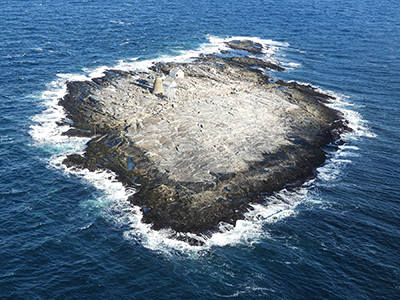
Nonprofit lighthouse groups are having to contend with many challenges in the wake of the January 2024 storms. A view of the storm-damaged boathouse at Wood Island Light, which was moved 20-feet off its foundation.
(Photo by Norm Labbe)
The powerful storms of January 10 and 13 may be in the “rear view mirror” of weather events, but the extensive damage they caused to Maine’s lighthouses remains with us. The scenes are surreal – and the adverse impact on the historical, programmatic, educational and environmental aspects of lighthouses, is quite significant.
For nonprofit lighthouse stewards, the recovery process is a challenging one. Not only are organizations scrambling to assess the sudden damage – an especially difficult task at offshore lighthouses during the wintertime, they must also determine how best to quickly stabilize compromised structures from further damage for the remainder of the storm season.

It is very difficult for lighthouse groups to visit offshore sites during the winter; making it challenging to obtain storm damage reports / planning the recovery process.
Mount Desert Rock – Maine’s most remote lighthouse.
(Photo by Bob Trapani, Jr.)
Of course, the biggest challenge facing lighthouse stewards is obtaining disaster relief funds. The storm damage at many sites is simply too great for normal nonprofit maintenance budgets to absorb. Yet there are scant options for organizations to leverage in times of emergency like this.
In an effort to help nonprofit lighthouse organizations overcome the obstacles associated with obtaining disaster relief funds, the American Lighthouse Foundation (ALF) is proactively exploring the concept of strength in numbers.
ALF has recently sent out questionnaires to nonprofit stewards of Maine’s lighthouses seeking information on the types of damages incurred at their site(s), ballpark cost estimates and ideas related to hazard mitigation solutions for future storms.

The boathouse at Whitehead Light Station suffered catastrophic damage during the January 13, 2024 storm.
(Photo courtesy of Whitehead Light)
Data from the questionnaires will provide a clearer picture as to the scope and estimated cost of the storm damage. It will also convey a more compelling story collectively than any given project could accomplish on their own.
And in light of climate change, this teamwork will go a long way in helping lighthouses formulate more effective measures for mitigating the adverse impact of future storms. Thus allowing us to better protect the financial investments into site preservation, public access programs and adaptive reuse initiatives.
When it comes to Federal Emergency Management Agency (FEMA) disaster relief funds, nonprofits are typically not prioritized as highly as state and municipal entities who suffer storm damage to critical coastal infrastructure.
FEMA is traditionally the payer of last resort – with options such as SBA loans and insurance coverage being preferred by FEMA for addressing damages and loss. However, for lighthouse organizations, flood insurance is generally unattainable and loans possess their own set of burdens.

Egg Rock Lighthouse suffered extensive damage during the January 2024 storms. This lighthouse is an icon on Frenchman Bay – and its sense of place is profound.
(Photo by Bob Trapani, Jr.)
Yet Maine’s lighthouses are irreplaceable historic treasures that contribute mightily to the state’s tourism industry, coastal fabric and overall sense of place for residents and visitors alike. Many of them also serve as active aids to navigation for mariners plying Maine waters. Lighthouses remain vitally important in a myriad of ways.
Therefore, the American Lighthouse Foundation is fervently investigating the option of working with a consulting firm that specializes in all areas of the disaster recovery life cycle – professionals who will help Maine lighthouses get the proper attention from FEMA that they so richly deserve.
Keeping the lights “shining” is a team effort – and in the wake of the recent storms and the impacts of climate change, the notion of working together is more important now than ever!

Halfway Rock Lighthouse in Casco Bay suffered heavy damage. The former keeper’s dwelling and boathouse were flooded and the station’s boat ramp was compromised extensively. Lighthouses like Halfway Rock are on the front lines of storms and climate change – they need our help now more than ever! (Photo by Ford Reiche)

